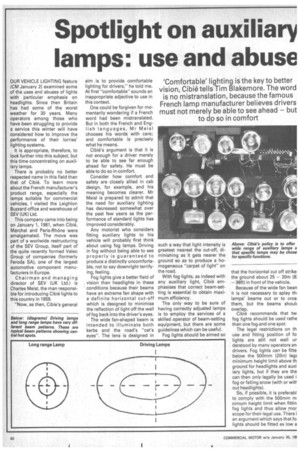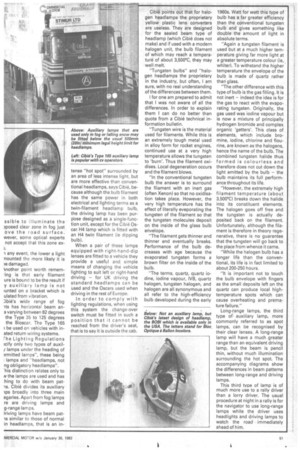Spotlight on auxiliary lamps: use and abuse
Page 48

Page 49

If you've noticed an error in this article please click here to report it so we can fix it.
'Comfortable' lighting is the key to better vision, Cibie tells Tim Blakemore. The word is no mistranslation, because the famous French lamp manufacturer believes drivers must not merely be able to see ahead — but to do so in comfort
OUR VEHICLE LIGHTING feature (CM January 2) examined some of the uses and abuses of lights with particular emphasis on headlights. Since then Britain has had some of the worst weather for 30 years. Many operators among those who have been struggling to provide a service this winter will have considered how to improve the performance of their lorries' lighting systems.
It is appropriate, therefore, to look further into this subject, but this time concentrating on auxiliary lamps.
There is probably no better respected name in this field than that of Cibie. To learn more about the French manufacturer's product range, especially the lamps suitable for commercial vehicles, I visited the Leighton Buzzard office and warehouse of SEV (UK) Ltd.
This company came into being on January 1, 1981, when Cibie, Marchal and Paris-Rhbne were amalgamated. The move was part of a worlwide restructuring of the SEV Group, itself part of the quite recently formed Valeo Group of companies (formerly Feroda SA), one of the largest automotive component manufacturers in Europe.
Chairman and managing director of SEV (UK Ltd.) is Charles Meisl, the man responsible for introducing Cibie lights to this country in 1959.
"Now, as then, Cibie's general aim is to provide comfortable lighting for drivers," he told me. At first "comfortable" sounds an inappropriate adjective to use in this context.
One could be forgiven for momentarily wondering if a French word had been mistranslated. But in both the French and English languages, Mr Meisl chooses his words with care; and comfortable is precisely what he means.
Cibie's argument is that it is not enough for a driver merely to be able to see far enough ahead for safety. He must be able to do so in comfort.
Consider how comfort and safety are closely allied in cab design, for example, and his meaning becomes clearer. Mr Meisl is prepared to admit that the need for auxiliary lighting has decreased somewhat over the past few years as the performance of standard lights has improved considerably.
Any motorist who considers fitting auxiliary lights to his vehicle will probably first think about using fog lamps. Driving in fog without being able to see properly is guaranteed to produce a distinctly uncomfortable, not to say downright terrifying, feeling.
Fog lights give a better field of vision than headlights in these conditions because their beams have an extreme fan shape with a definite horizontal cut-off which is designed to minimise the reflection of light off the wall of fog back into the driver's eyes.
The wide fan-shaped beam is intended to illuminate both kerbs and the road's "cat's eyes". The lens is designed in such a way that light intensity is greatest nearest the cut-off, diminishing as it gets nearer the ground so as to produce a homogeneous "carpet of light" on the road.
With fog lights, as indeed with any auxiliary light, Cibie emphasises that correct beam-setting is essential to obtain maximum efficiency.
The only way to be sure of having correctly adjusted lamps is to employ the services of a skilled operator of beam-setting equipment, but there are some guidelines which can be useful.
Fog lights should be aimed so that the horizontal cut off strike the ground about 25 — 30m (8: — 98ft) in front of the vehicle.
Because of the wide fan bean it is not necessary to splay till lamps' beams out or to cros: them, but the beams shout( overlap. Cibie recommends that tw fog lights should be used rathe than one fog and one spot.
The legal restrictions on th use and fitting position of fo lights are still not well ur derstood by many operators an drivers. Fog lights can be fitte below the 500mm (20in) legi minimum height limit above th ground for headlights and auxi iary lights, but if they are the can then only legally be used i fog or falling snow (with or witF out headlights).
So, if possible, it is preferabl to comply with the 500mm m nimum height limit when fittin fog lights and thus allow mor scope for their legal use. There i an argument which says that fo lights should be fitted as low a ssible to illuminate the Noosed clear zone in fog just ove the road surface. wever, some optical experts not accept that this zone ex any event, the lower a light nounted the more likely it is )e damaged.
knother point worth rememPing is that early filament ure is bound to be the result if y auxiliary lamp is not ounted on a bracket which is ulated from vibration.
:ibie's wide range of fog its has horizontal beam ans varying between 82 degrees the Type 35 to 125 degrees the Bioscar. The Type 165 be used on vehicles with inated return wiring systems. rhe Lighting Regulations :cify only two types of auxil/ lamps under the heading of ?smitted lamps", these being I lamps and "headlamps, not ng obligatory headlamps". his distinction relates only to (1/4/ the lamps are used and has :hing to do with beam patns. Cibie divides its auxiliary Ips broadly into three main egaries. Apart from fog lamps re are driving lamps and 9-range lamps.
)riving lamps have beam patis similar to those of normal in headlamps, that is an in tense "hot spot" surrounded by an area of less intense light, but are more effective than conventional headlamps, says Cibie, because although the bulb filament has the same power in both electrical and lighting terms as a twin-filament headlamp bulb, the driving lamp has been purpose designed as a single-function unit, except for the Cibie Oscar H4 lamp which is fitted with an H4 twin filament (ie dipping bulb).
When a pair of these lamps equipped with right-hand-dip lenses are fitted to a vehicle they provide a useful and simple means of changing the vehicle lighting to suit left or right-hand driving — for UK driving the standard headlamps can be Used and the Oscars used when driving in the rest of Europe.
In order to comply with lighting regulations, when using this system the change-over switch must be fitted in such a position that it cannot be reached from the driver's seat, that is to say it is outside the cab. Cibie points out that for halogen headlamps the proprietary yellow plastic lens converters are useless. They are designed for the sealed beam type of headlamp (which Cibie does not make) and if used with a modern halogen unit, the bulb filament of which may reach a temperature of about 3,500°C, they may well melt.
"Tungsten bulbs" and "halogen headlamps the proprietary in the industry, but often, I am sure, with no real understanding of the differences between them.
I for one am prepared to admit that I was not aware of all the differences. In order to explain them I can do no better than quote from a Cibie technical information bulletin.
"Tungsten wire is the material used for filaments. While this is an extremely tough metal used in alloy form for rocket engines, continued use at a very high temperature allows the tungsten to 'burn'. Thus the filament oxidises. Local degeneration occurs and the filament blows.
"In the conventional tungsten bulb the answer is to surround the filament with an inert gas (often Xenon) so that no oxidisation takes place. However, the very high temperature has the effect of literally eveporating the tungsten of the filament so that the tungsten molecules deposit on the inside of the glass bulb envelope.
"The filament gets thinner and thinner and eventually breaks. Performance of the bulb decreases with age because the evaporated tungsten forms a brown filter on the inside of the bulb.
"The terms, quartz, quartz iodine, iodine vapour, IVB, quartz halogen, tungsten halogen, and halogen are all synonymous and all refer to the high-efficiency bulb developed during the early 1960s. Watt for watt this type of bulb has a far greater efficiency than the conventional tungsten bulb and gives something like double the amount of light in absolute terms.
"Again a tungsten filament is used but at a much higher temperature giving far more light at a greater temperature colour (ie, whiter). To withstand the higher temperature the envelope of the bulb is made of quartz rather than glass.
"The other difference with this type of bulb is the gas filling. It is not inert — indeed the idea is for the gas to react with the evaporating tungsten. Originally, the gas used was iodine vapour but is now a mixture of principally hydrogen bromide and complex organic 'getters'. This class of elements, which include bromine, iodine, chlorine and flourine, are known as the halogens, hence the name of the bulb. The combined tungsten halide thus formed is colourless and therefore does not cut down the light emitted by the bulb — the bulb maintains its full performance throughout its life.
"However, the extremely high filament temperature (about 3,500°C) breaks down the halide into its constituent elements. The halogen goes off free and the tungsten is actually deposited back on the filament. Unfortunately, although the filament is therefore in theory regenerative, there is no guarantee that the tungsten will go back to the place from whence it came.
"While the halogen bulb has a longer life than the conventional, its life is in fact limited to about 200-250 hours.
"It is important not to touch the bulb envelope with fingers as the small deposits left on the quartz can produce local hightemperature spots which can cause overheating and premature failure."
Long-range lamps, the third type of auxiliary lamp, more commonly referred to as spot lamps, can be recognised by their clear lenses. A long-range lamp will have a much greater range than an equivalent driving lamp, but the beam is pencil thin, without much illumination surrounding the hot spot. The accompanying diagrams show the differences in beam patterns between long-range and driving lamps.
This third type of lamp is of much more use to a rally driver than a lorry driver. The usual procedure at night in a rally is for the navigator to use long-range lamps while the driver uses headlights and driving lamps to watch the road immediately ahead of him.
























































